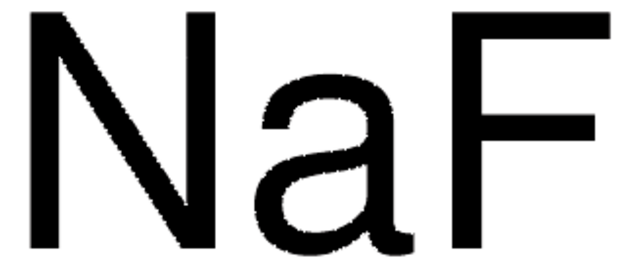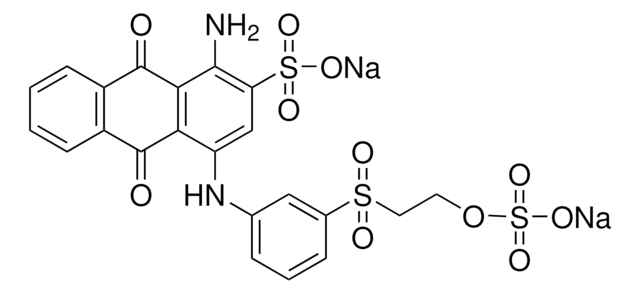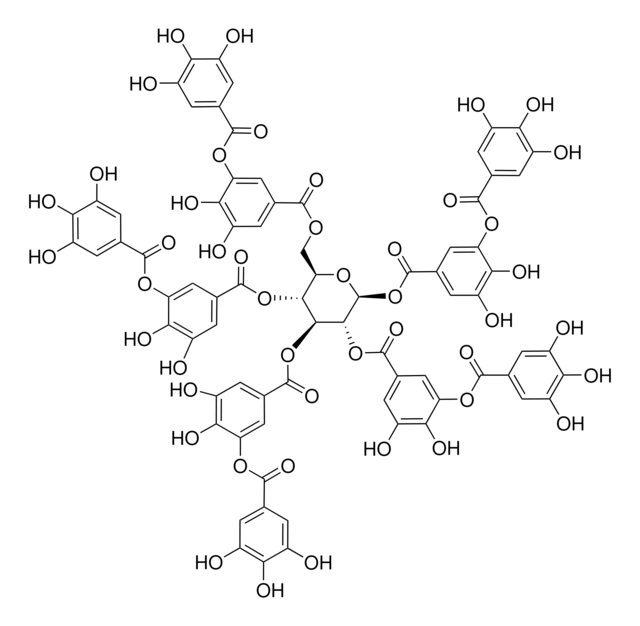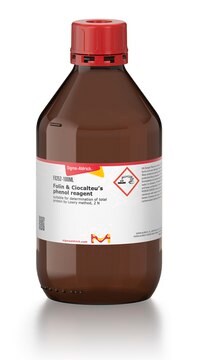S1504
Sodium fluoride
ReagentPlus®, ≥99%
Iniciar sesiónpara Ver la Fijación de precios por contrato y de la organización
About This Item
Fórmula lineal:
NaF
Número de CAS:
Peso molecular:
41.99
Número CE:
Número MDL:
Código UNSPSC:
12352302
ID de la sustancia en PubChem:
NACRES:
NA.21
Productos recomendados
grado
reagent
presión de vapor
1.4 mmHg ( 0 °C)
Línea del producto
ReagentPlus®
Ensayo
≥99%
Formulario
powder
mp
993 °C (lit.)
cadena SMILES
[F-].[Na+]
InChI
1S/FH.Na/h1H;/q;+1/p-1
Clave InChI
PUZPDOWCWNUUKD-UHFFFAOYSA-M
¿Está buscando productos similares? Visita Guía de comparación de productos
Categorías relacionadas
Aplicación
- Investigations of the reaction mechanism of sodium with hydrogen fluoride to form sodium fluoride and the adsorption of hydrogen fluoride on sodium fluoride monomer and tetramer.: The paper delves into the reaction mechanisms between sodium and hydrogen fluoride, and the adsorption properties of hydrogen fluoride on sodium fluoride structures, which are vital for chemical synthesis and industrial applications (Yu et al., 2024).
Información legal
ReagentPlus is a registered trademark of Merck KGaA, Darmstadt, Germany
Palabra de señalización
Danger
Frases de peligro
Consejos de prudencia
Clasificaciones de peligro
Acute Tox. 3 Oral - Eye Irrit. 2 - Skin Irrit. 2
Riesgos supl.
Código de clase de almacenamiento
6.1D - Non-combustible acute toxic Cat.3 / toxic hazardous materials or hazardous materials causing chronic effects
Clase de riesgo para el agua (WGK)
WGK 1
Punto de inflamabilidad (°F)
Not applicable
Punto de inflamabilidad (°C)
Not applicable
Elija entre una de las versiones más recientes:
¿Ya tiene este producto?
Encuentre la documentación para los productos que ha comprado recientemente en la Biblioteca de documentos.
Los clientes también vieron
Ryan D Espy et al.
Analytical chemistry, 86(15), 7712-7718 (2014-06-28)
Determination of eight drugs of abuse in blood has been performed using paper spray or extraction spray mass spectrometry in under 2 min with minimal sample preparation. A method has been optimized for quantification of amphetamine, methamphetamine, 3,4-methylenedioxyamphetamine (MDA), 3,4-methylenedioxy-N-methylamphetamine
Melissa van Kranenburg et al.
Human mutation, 36(2), 200-209 (2014-11-05)
The mechanistic target of rapamycin complex 1 (TORC1) senses nutrient availability to regulate eukaryotic anabolic metabolism. In response to limiting concentrations of amino acids, TORC1 kinase activity is inhibited through the GATOR-1 complex. Mutations in DEPDC5, that encodes one of
Madeleen Bosma et al.
Biochimica et biophysica acta, 1841(12), 1648-1655 (2014-09-25)
We used human cardiomyocyte-derived cells to create an in vitro model to study lipid metabolism and explored the effects of PPARγ; ACSL1 and ATGL on fatty acid-induced ER stress. Compared to oleate, palmitate treatment resulted in less intracellular accumulation of
M Ogawa et al.
Veterinary pathology, 52(6), 1099-1107 (2015-03-04)
Canine degenerative myelopathy (DM) is a progressive neurodegenerative disease frequently found in Pembroke Welsh Corgi (PWC) dogs, and it has clinical and pathologic similarities to human amyotrophic lateral sclerosis. Autophagy is a major intracellular protein degradation system. Abnormalities of autophagy--resulting
Nibaldo C Inestrosa et al.
Brain pathology (Zurich, Switzerland), 25(6), 679-691 (2014-10-30)
Alzheimer's disease (AD) is the most common neurodegenerative disorder and the leading cause of age-related dementia worldwide. Several models for AD have been developed to provide information regarding the initial changes that lead to degeneration. Transgenic mouse models recapitulate many
Nuestro equipo de científicos tiene experiencia en todas las áreas de investigación: Ciencias de la vida, Ciencia de los materiales, Síntesis química, Cromatografía, Analítica y muchas otras.
Póngase en contacto con el Servicio técnico








